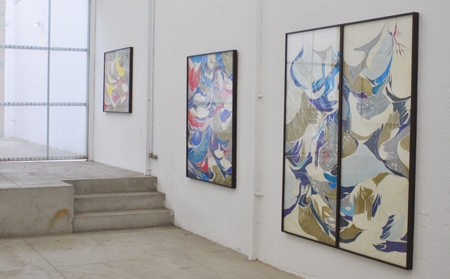There are at least two ways of seeing the set of 8 drawings presented by Marcia de Moraes at the show Personne. The first way is the surprise of one who is not familiar with the domain of composition of this 29 years old young artist from São Paulo. The other comes from one who already knows her trajectory. Marcia has accentually changed the colors of her works.
Until recently, the artist had been showing a palette of light colors to fill undefined shapes. Nearly always, the result was works with a strong visual appeal but also serene.
Marcia added another element to this contradictory panel. With the genuine intention of adding a new problematic to her compositions, the artist now uses more flashy/striking colours. But she didn’t take the beige, the light blue, the dark red of former works.
On Rayuela, the light yellow is now closer to the almost fluorescent orange. Small patches of lime green appear on one side of La vida es sueño II. Marcia sought a challenge and succeeded in solving it: to create an equal relationship between these new colors and the ones she already used.
Marcia’s drawings raise issues related to more traditional pictorial composition, but also to something more experimental theorized by Helio Oiticica. On September 7, 1960, the Carioca artist noted in his notebook full of short texts: “When the color is not subjected to the rectangle or any representation on this rectangle, it tends to ’embody’; become temporal, creates its own structure, the work then becomes the body of color.”
Marcia’s new drawings remain quiet on white background rectangles. Still referring to sighs, calm winds and a jelly that melts slowly. However, even within its limits and silence, there is in them a sort of experimentation, an embodiment similar to the one Oiticica theorized, but still two-dimensional.
Usually, the works by Marcia have titles of literary works such as El amor en los tiempos del Cólera, by Gabriel García Márquez, and Le Rouge et le Noir, by Stendhal. Many can create relations between the storylines of these books and drawings related to them. In my view, they are relationships that only reduce one of the most interesting marks in Marcia’s work: the assumed abstraction, which ensures itself without any foot in this flat reality we live in. Not without a reason, the artist often repeats: “I draw what I have never seen”.
Dubiousness is a word that works to describe her drawings. In Marcia’s artistic choices, what is shape/form, heavily streaked with graffiti, slides through the paper. Marcia searches for contradictions somewhere unknown and places those contradictions into her works. Even if their arrangement is relative, like her drawings, filled with blank spaces.
Marcia de Moraes (São Carlos, 1981, lives and works in São Paulo) is a bachelor and master of fine arts at Unicamp. Since 2008 she takes part of the Ateliê Fidalga in São Paulo. In 2009, she had her first solo exhibition at the Centro Universitário Maria Antonia, also in São Paulo. The artist is regularly in group shows in Brazil and abroad, among which stand out: Ateliê Fidalga no Paço das Artes, São Paulo, 2010, Edital de Exposições do MARP, Museu de Arte de Ribeirão Preto, 2009. In 2010 she will take part of the fifth edition of the show Paralela, A Contemplação do Mundo, and will do a residency at La Cour Dieu in La Roche, France.
(*) Bruno Moreschi is a journalist specialized in fine arts.
